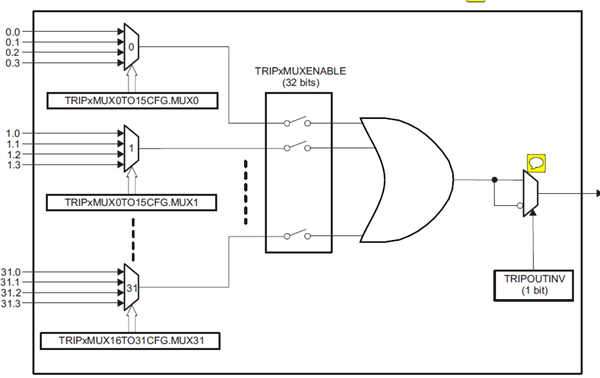Tool/software: TI-RTOS
This is the the architecture of EPWMXBAR, In this architecture All muxes which are enabled will be logically OR’d before being passed on to the respective TRIPx signal on the ePWM. But my questions is the function of OR’d.
I think the purpose of the OR’d is expand the source to trip the EPWM Trip-Zone submodule
(for eg,there is 5 external faults,we can set the epwmxbar register TRIP4 correspond to this 5 external faults,
EPwmXbarRegs.TRIP4MUX0TO15CFG.bit.Mux1 = 1; //inputxbar1 trip
EPwmXbarRegs.TRIP4MUX0TO15CFG.bit.Mux3 = 1; //inputxbar2 trip
EPwmXbarRegs.TRIP4MUX0TO15CFG.bit.Mux5 = 1; //inputxbar3 trip
EPwmXbarRegs.TRIP4MUX0TO15CFG.bit.Mux7 = 1; //inputxbar4 trip
EPwmXbarRegs.TRIP4MUX0TO15CFG.bit.Mux9 = 1;
)
So If there is one fualt happend we can blockade the pwm.
But if we want use this functions We must set the fault signals status "L" is represent normal ,and "H" is fault . But in most case The "H" is represent normal ,and "L" is fault(for eg IPM's fault is "L").So in this case we can't use the or'd to expand the source to blockade the pwm.
My questions is in the above case how to expand the source to blockade the pwm? In the EPWMXBAR architecture why is "OR'd" why not "AND'd"(we can set the normal status of CmpssH and CmpssL is "H" so we can use "AND'd" instead "OR'd")?
Thank you for your answer.
Regard
shook.


